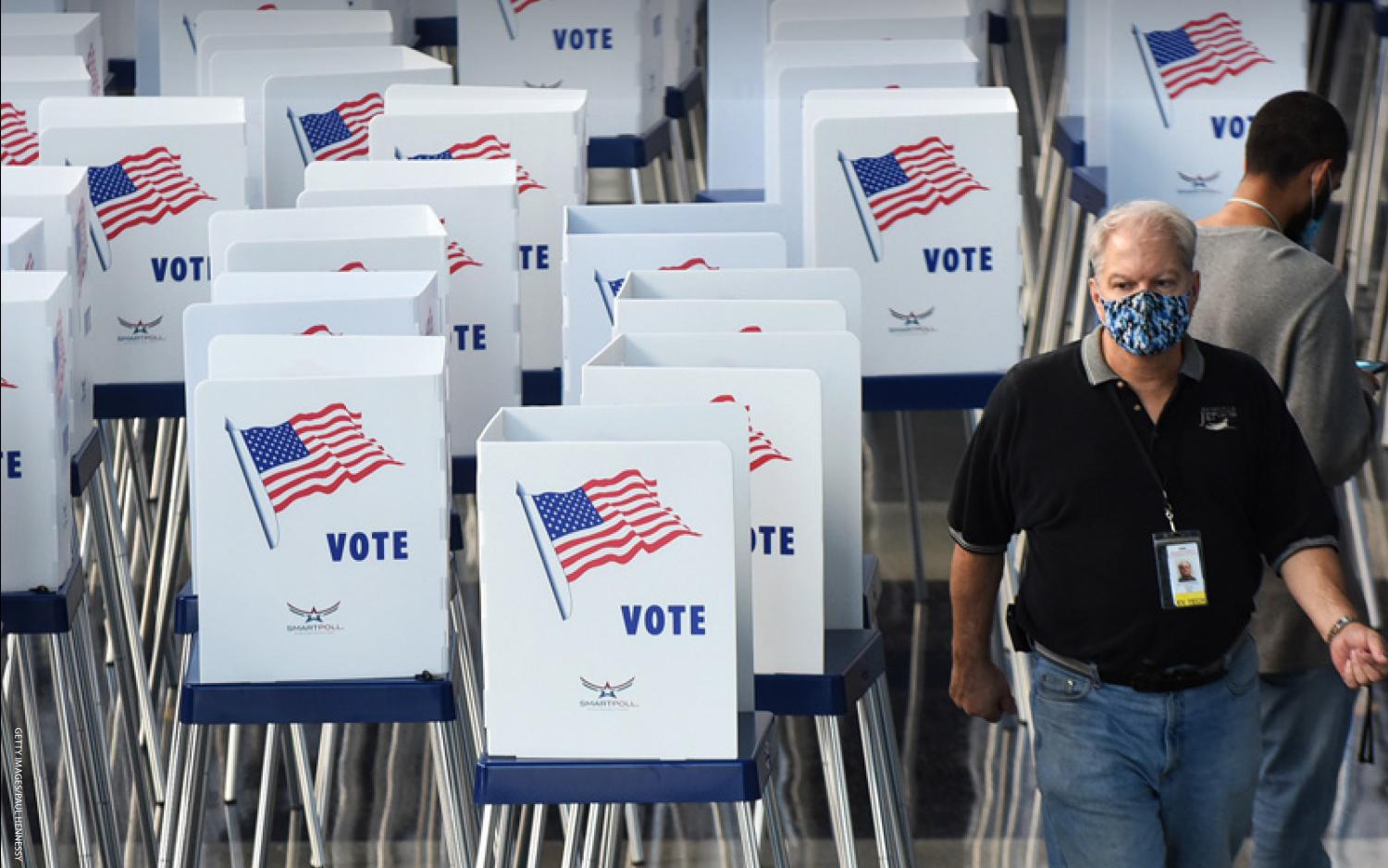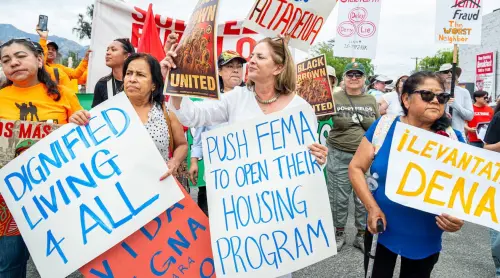Demographics are not destiny, but steady and predictable changes to the electorate play an important role in defining the landscape of American politics. Just as the country’s population has changed substantially over the last several decades—growing older, more educated, and more racially diverse—we expect those changes to continue over the next several decades. At its heart, the States of Change project takes these changes seriously and tries to understand how they might influence American politics.
In our 2018 report, we examined an array of future presidential election scenarios— from 2020 through 2036—that could arise as the demography of the nation and its 50 states changes over the next several decades.
In this 2020 report, we update our electoral scenarios in several important ways. First, we have produced a new set of underlying demographic projections for the nation and all 50 states plus the District of Columbia based on the latest census data. These projections trace the probable path of demographic change across the country—both for the population as a whole and, importantly, for eligible voters.
Second, we have explicitly incorporated gender into our projections and scenarios for the first time. This is not because the population distribution between men and women is likely to change but because gender has become a more prominent dividing line in vote behavior both overall and within many demographic groups.
Finally, and most importantly, we have included generations in our partitioning of the electorate and built electoral simulations that explicitly grapple with narratives about the likely evolution of generational cohorts over the next several decades.
We use the term electoral simulations quite intentionally. This report and those that came before it are not about predicting the future. If we carried any illusions about the feasibility of foreseeing what lays ahead, the tumultuous events of the last four years have surely robbed us of this notion.
Instead, the point is to try and map out the potential influence of the pieces of the future that are relatively knowable. That allows us to provide rigorous baselines for thinking about how a given phenomenon might shape things under several plausible scenarios. While we may not know whether the election of 2024 will take place during a recession or an economic boom, we can nevertheless paint a reasonably accurate portrait of the nation’s underlying demographic landscape for that election.
In our previous reports, our electoral simulations assumed that party preferences for a given demographic group defined by age, race, education, and state—say, Hispanic Californians with a college degree between the ages of 45 and 64—would hold constant throughout a given simulation. The reason elections produced different results over time in these simulations was due to the fact that these groups were growing and shrinking as a share of all eligible voters—not that their preferences for a Democratic or Republican candidate were changing.
Beyond judging whether a simulation like this is realistic or unrealistic, it is better to think of it as being an exploration of a very particular idea: What would election results look like in the future if the only thing that changed was the relative size of different demographic groups defined by race, age, education and state?
In this year’s report, we explore a different idea. In contrast to our previous reports— which held the political preferences of these demographic groups constant—we simulate what would happen if cohorts of voters defined by their birth year, such as Millennials or Baby Boomers, held onto their political preferences as they aged.

To put this scenario in context, one common narrative about American voters is that they are liberal and Democratic leaning in their youth and grow more conservative and Republican leaning as they age. The most coherent version of this story is that certain types of life events like home ownership, marriage, and raising children lead people to become more conservative and Republican leaning as they age.
This idea has led some to dismiss the salience of generational cohorts in modern politics. At some level, they are assuming that the political leanings of America’s youngest generations will shift substantially as they age and simply recreate the current political equilibrium rather than changing the political landscape. However, this ignores a number of ways in which the trajectory of today’s youngest cohorts may be different than their predecessors.
First, not all generations start out equally liberal and Democratic leaning in their youth. Notably, Millennials and Generation Z appear to be far more Democratic leaning than their predecessors were at the same age. Even if today’s youngest generations do grow more conservative as they age, it’s not at all clear they would end up as conservative as older generations are today.
Second, it’s clear that younger generations are on a different trajectory than older generations when it comes to some of those conservatizing life events such as home ownership, marriage, and raising children. All of those milestones are, on average, occurring later in life for these cohorts—if they are occurring at all. Hypothetically, this means that the conservatizing effect of aging apparent in some earlier generations may be muted. To date, this is consistent with the data we have. For example, there has not been a significant shift among Millennials, the oldest of whom are now in their late 30s.
Third, America’s youngest generations are more racially and ethnically diverse than older generations. This is important because it would appear that nonwhite Americans are somewhat less affected by cohort effects than white Americans. Thus, the kinds of changes and effects we are accustomed to talking about among generations that are overwhelmingly white may not apply cleanly to more racially and ethnically diverse generations.
In the case that any or all of these caveats are applicable—and only time will tell if they are—it suggests that the potential impact of generational change could be far greater than that assumed by the conventional “liberal when young, conservative when old” model of American political behavior. This means that the generational simulations in this report likely provide some very relevant insights into how the incentives of American politics could change as the generational landscape changes.
In this report, we show that incorporating generational cohorts into one’s analysis has a potentially substantial impact on the political landscape of future elections. We do this using four scenarios:
- No generational effects. This simulation assumes voting and turnout patterns from the 2016 presidential race remain the same in future elections for all demographic groups defined by race, age, education, gender and state. The only thing that changes is the size of these various groups among eligible voters. Such a scenario takes no account of the changing generational composition of the electorate and serves as a baseline for judging the impact of incorporating generational preferences.
- Full generational effects. This simulation assumes that generational political preferences will remain the same in future elections. Put simply, instead of assuming that younger voters vote exactly like older groups as they age, this scenario assumes that each generational cohort will continue to vote in future elections like they did in the 2016 presidential election. Like the first scenario, this scenario also accounts for changes in the underlying composition of the electorate by race, education, gender, and state. Age-related turnout rates for various groups are held constant at the levels assumed in the age-based simulation.

- Generation effects decline with age. This simulation assumes that generational political preferences will carry forward into future elections, as in the second simulation, but also assumes that generations will become more conservative as they age. Like the first two scenario, this scenario also accounts for changes in the underlying composition of the electorate and holds the age-related turnout rates of groups constant over time.
- Post-Millennial generations more conservative. This simulation assumes that generational political preferences will fully carry forward into future elections but assumes that Gen Z and the as-yet unnamed generation following them will be more conservative than the Millennial generation. As in our other scenarios, this scenario also accounts for changes in the underlying composition of electorate and holds the age-related turnout rates for various groups constant going forward into future elections.
There are two key findings from these scenarios.
First, the underlying demographic changes our country is likely to experience over the next several elections generally favor the Democratic party. The projected growth of groups by race, age, education, gender and state tends to be more robust among Democratic-leaning groups, creating a consistent and growing headwind for the Republican party. This will require the GOP to improve their performance among key demographic groups, election after election, just to keep their vote share competitive as illustrated by our first, age-based simulation that includes no generational effects. That simulation finds Michigan and Pennsylvania moving Democratic in 2020, with later elections in the 2020s adding Florida, Wisconsin, Georgia, and North Carolina to the Democratic column.
Second, incorporating generational cohorts into this analysis dramatically accelerates the rate at which America’s political terrain could potentially shift, as shown by our second, generation-based, scenario. That scenario finds Michigan, Pennsylvania, Wisconsin, Florida, and Arizona moving Democratic in 2020, with later elections in the decade adding Georgia, North Carolina, Texas, and Ohio to the Democratic tally.
Even under scenarios where cohorts grow more conservative as they age or younger generations are substantially more conservative, these changes are still far faster than with simulations that consider only age groups and ignore the way generational changes can reshape the electorate.
The States of Change project has always argued that demographic change is important for understanding the future of American politics. This year’s report shows that the potential influence of generational growth and decline needs to be integrated into that understanding.
About the project
The States of Change: Demographics and Democracy project is a collaboration supported by The William and Flora Hewlett Foundation and the Democracy Fund that brings together the Center for American Progress, the Bipartisan Policy Center, demographer William H. Frey of the Brookings Institution, and Rob Griffin of the Democracy Fund Voter Study Group. The views expressed in this and other States of Change reports are those of the authors and not the institutions sponsoring the project.
The project’s goals are:
- To document and analyze the challenges to democracy posed by the rapid demographic evolution from the 1970s to 2060
- To project the race-ethnic composition of every state to 2060, which has not been done in more than 20 years
- To promote a wide-ranging and bipartisan discussion of America’s demographic future and what it portends for the nation’s political parties and public policy.
This report explores how demographic changes could shape the next five presidential elections using national and state projections. The demographics we look at are race, age, education, gender, and generation, using a new set of projections for the nation and all 50 states. We focus on what those projections imply for the presidential elections between 2020 and 2036 under different assumptions about future turnout and voter preference patterns by these demographics, with a particularly close look at generational change.
The Brookings Institution is committed to quality, independence, and impact.
We are supported by a diverse array of funders. In line with our values and policies, each Brookings publication represents the sole views of its author(s).








